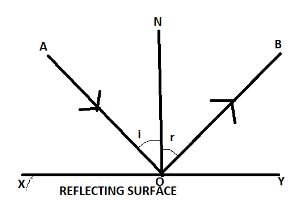
States the laws of reflection.
Answer
541.8k+ views
Hint:When light travelling in a medium strikes a reflecting surface, it goes back into the same medium obeying various laws. This phenomenon is known as reflection of light. These various laws are known as laws if reflection. These laws are stated below in the complete solution.
Complete answer:
Reflection of light obey the following laws:
-The incident ray, the normal at the point of incidence and the reflected ray all lie in the same plane.
-The angle of incidence is always equal to the angle of reflection. $\angle i = \angle r$
-Incident ray and the refracted ray are on different sides of normal.
These observations are known as the laws of reflection.

When a ray of light falls on a mirror normally, both the angle of incidence and the angle of reflection are zero.
Additional information:
When a parallel beam of light falls on a mirror (plane or curved), each ray of light is reflected from the mirror according to the laws of reflection it is called regular reflection. However, when the parallel beam of light falls on an object, wall, floor, paper etc., the rays of light are reflected in all possible directions such a reflection is known as diffuse reflection. The cause of diffuse reflection is not perfectly smooth like a mirror.
Note:Reflection causes echoes due to this property it is often used in sonars. If we change the direction of incidence it will change the angle of the plane too. As the angle of incidence increases will lead to increase the direction of reflection too because these two angles are equal.
Complete answer:
Reflection of light obey the following laws:
-The incident ray, the normal at the point of incidence and the reflected ray all lie in the same plane.
-The angle of incidence is always equal to the angle of reflection. $\angle i = \angle r$
-Incident ray and the refracted ray are on different sides of normal.
These observations are known as the laws of reflection.

When a ray of light falls on a mirror normally, both the angle of incidence and the angle of reflection are zero.
Additional information:
When a parallel beam of light falls on a mirror (plane or curved), each ray of light is reflected from the mirror according to the laws of reflection it is called regular reflection. However, when the parallel beam of light falls on an object, wall, floor, paper etc., the rays of light are reflected in all possible directions such a reflection is known as diffuse reflection. The cause of diffuse reflection is not perfectly smooth like a mirror.
Note:Reflection causes echoes due to this property it is often used in sonars. If we change the direction of incidence it will change the angle of the plane too. As the angle of incidence increases will lead to increase the direction of reflection too because these two angles are equal.
Recently Updated Pages
Master Class 12 Business Studies: Engaging Questions & Answers for Success

Master Class 12 Economics: Engaging Questions & Answers for Success

Master Class 12 English: Engaging Questions & Answers for Success

Master Class 12 Maths: Engaging Questions & Answers for Success

Master Class 12 Social Science: Engaging Questions & Answers for Success

Master Class 12 Chemistry: Engaging Questions & Answers for Success

Trending doubts
What are the major means of transport Explain each class 12 social science CBSE

Which are the Top 10 Largest Countries of the World?

Draw a labelled sketch of the human eye class 12 physics CBSE

How much time does it take to bleed after eating p class 12 biology CBSE

Explain sex determination in humans with line diag class 12 biology CBSE

Differentiate between homogeneous and heterogeneous class 12 chemistry CBSE




